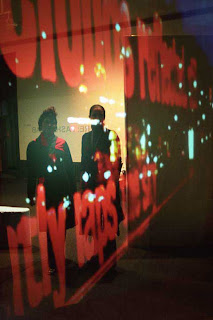Infrastructure
In order to allow for an interaction between user and space to occur naturally, small gadgets and devices commonly used to hold digital information were eliminated. The intent was to place an invisible electronic infrastructure map onto the physical space itself. The system features a standard Ethernet network, a server, sensors, and output devices.
As visitors browse through fashion artifacts and pick them up, they are labeled with discreet radio frequency chips which are embedded into the fashion items. Their movements and actions are monitored as the sensors for the chips are invisibly distributed throughout the space, triggering one of several “active zones” found throughout the store. The space reacts to the individual with a variety of output media tracing back to a central server. This concept of a spatially distributed interface can be referred to as “interspace”.
Interaction
The code of the item is relayed to the server to the source of information from the network in real time. The reflection of the visitor’s protons in the mirror results in an overlay of digital content. In this sense, a new relationship between body and information is formed while the surrounding environment acts as the enabling surface.
 _customized interaction between each individual user and specific space_The ReFashion Lab: Building Digital Matter and Hybrid Space, ISEA Conference in Nagoya, Japan Nov_02
_customized interaction between each individual user and specific space_The ReFashion Lab: Building Digital Matter and Hybrid Space, ISEA Conference in Nagoya, Japan Nov_02
 _item information displayed on metaMirror_Interactive Institute SMART Studio
_item information displayed on metaMirror_Interactive Institute SMART Studio
No comments:
Post a Comment